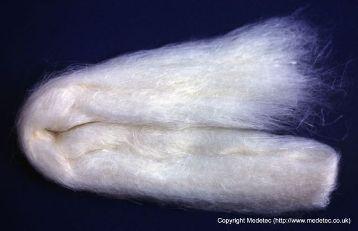What is an Alginate Dressing?
September 29, 2017
By the WoundSource Editors
What is an Alginate Dressing?
Biodegradable alginate dressings made from seaweed date back at least fifty years and commercially available alginate has been available since 1983. Often used on wounds with heavy exudate, the alginates used to produce these dressings are made from a variety of seaweeds harvested around the world. Arguably underused, these dressings are not well studied and documented in the medical literature compared to other modern dressings.
Composition of Alginate Dressings
Early use of alginate dressing consisted of fibers of calcium alginate formed into a loose fleece. Recently, this structure has been improved by entangling the fibers so that the dressing is stronger when it becomes soaked with blood or exudate. Alginate dressings can absorb 15-20 times their own weight in exudate and are manufactured in a range of products including flat sheets, ropes, and ribbons. Rope and ribbon dressings are used to pack cavity wounds, while flat sheets are used on surface wounds. Some products are self-adhesive but an appropriate secondary dressing is often used to keep the alginate in place and contain excess exudate.
Sodium alginate is used in some products in order to improve gelling. Other products improve stability by using freeze-dried alginate. The nature of the gel depends on the M, G, and MG groups contained in the alginate. Alginate dressing with high M groups have ribbon-like, flat molecular appearances and form a quicker, softer and more elastic gel. G-rich alginate dressing creates a more chain-like and buckled gel that forms more slowly. G-rich alginate dressings are easy to remove intact, while M-rich alginate dressings tend to dissolve, although they can be removed with irrigation using saline. Note: These “dissolving” alginates should never be put into a sinus tract or tunneling wound.
Some alginate dressing products also have antimicrobial materials added, such as zinc or silver. Generally, these should only be used according to best practices of antimicrobial dressings for a maximum of 14 days by prescription. Always refer to the manufacturer's instructions for use.
How do Alginate Dressings Assist in Healing?
When used to dress a wound which is exuding heavily, the calcium ions in the dressing interact with the sodium ions in the fluid of the wound. This reaction makes the fiber in the dressing to swell and partially dissolve into a gel. How much the alginate dressing swells depends on the chemical composition of the product and the botanical source
Indicated Wounds for Alginate Dressings
Alginates can be used in a variety of wound situations. With sloughy wounds that also produce exudate, the alginate dressing provides a moist cover to prevent the wound from drying out and allowing the wound to heal more quickly. Common wound situations where alginate dressing can be applied are:
- Pressure ulcers
- Diabetic foot ulcers
- Cavity wounds
- Venous leg ulcers
- Post-operative wounds
- Trauma wounds
- Partial thickness burns
Most of the time, alginate dressings can be left unchanged for 5-7 days unless exudate capacity is reached. With infected wounds, the wound bed should be inspected daily.
Steps in Using Alginate Dressings
In general, using an alginate dressing is a straightforward process that follows the best practices of wound care:
- Use saline (or wound cleanser) to clean the wound area.
- Pat the wound dry.
- Place the alginate dressing on the wound.
- If required, place a secondary dressing on top the alginate to hold it in place and to absorb excess fluid.
- Inspect the dressing daily, examining the wound site daily if infected.
- Change the bandage once every 5-7 days or when exudate leaks from the edges or into the secondary bandage.
- When removing the alginate dressing, use saline to dampen it first and avoid damage to the (the wound bed/granulation tissue)
- If the dressing sticks to the wound, use saline irrigation to rinse.
Benefits of Alginate Dressings
Along with being an excellent absorbent, alginate dressings protect the affected area from bacterial infections and maintain a moist environment that promotes quicker and more efficient healing. Alginate dressing is easy to apply and has high manipulability. Furthermore, few individuals are allergic to alginates.
Contraindications
Alginate dressing is not an appropriate treatment for a wound that is bleeding heavily, or for wounds that are dry or have minimal exudate. They are also not a good choice for surgical implantations or third-degree burns. Other counter-indications are an allergy to any of the components in the dressing. Caution should also be used in using the dressing on tumors or any wound with exposed blood vessels because removing the dressing may cause fresh bleeding.
While not as well-known as some other dressing types, alginate dressing has properties which make it a good choice for a variety of wound types, especially wounds requiring absorbent dressing.
The views and opinions expressed in this blog are solely those of the author, and do not represent the views of IncontinenceSource, Kestrel Health Information, Inc., its affiliates, or subsidiary companies.
The views and opinions expressed in this blog are solely those of the author, and do not represent the views of WoundSource, HMP Global, its affiliates, or subsidiary companies.









Follow WoundSource
Tweets by WoundSource